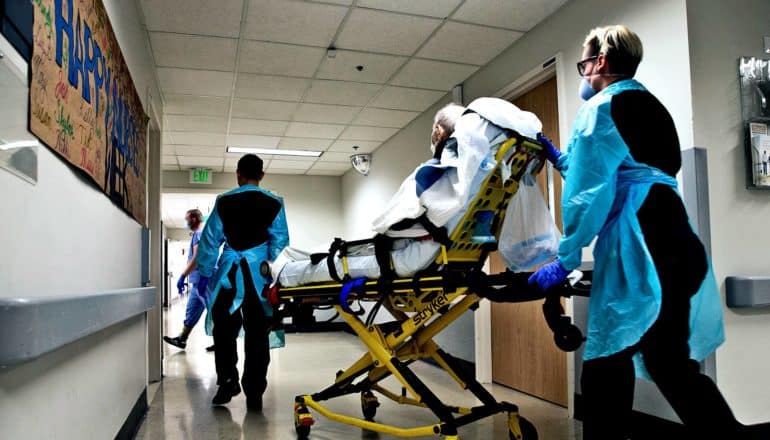
People hospitalized with COVID-19 have a low risk of stroke, according to new study.
While initial reports had suggested a significant risk for these patients, the new study finds the majority of afflicted patients had existing risk factors, such as high blood pressure and diabetes.
The findings provide more clarity about the role COVID-19 plays in causing stroke in a diverse population of the United States.
“While there was initial concern for a high number of strokes related to COVID-19, that has not been born out,” says Brett Cucchiara, an associate professor of neurology in the Perelman School of Medicine at the University of Pennsylvania, and senior author of the paper in the journal Stroke.
“Importantly, while the risk for stroke in COVID-19 patients is low, it’s mostly tied to pre-existing conditions—so physicians who do see stroke in hospitalized COVID-19 patients must understand the virus is not the only factor, and it’s necessary to follow through with normal diagnostic testing.”
“However, there are still many unknowns and we need to continue investigating the linkage between stroke and COVID-19, particularly considering the racial disparities surrounding the disease.”
COVID-19 and stroke risk
To evaluate the risk and incidence of stroke in COVID-19 hospitalized patients, researchers analyzed data from 844 COVID-19 patients admitted to the Hospital of the University of Pennsylvania, Penn Presbyterian Medical Center, and Pennsylvania Hospital between March and May. The team also analyzed the data for cases of intracranial hemorrhage (bleeding in the brain).
Researchers found that 2.4% of patients hospitalized for COVID-19 had an ischemic stroke—the most common type of stroke, typically caused by a blood clot in the brain.
Importantly, the majority of these stroke patients had existing risk factors, such as high blood pressure (95%) and a history of diabetes (60%), and traditional stroke mechanisms, such as heart failure. Additionally, over one-third had a history of a previous stroke.
Researchers say the results suggest that these cerebrovascular events in hospitalized COVID-19 patients are likely tied to existing conditions, and not the sole consequence of the virus. However, other factors may exist and require continued research.
While the precise mechanisms linking cerebrovascular events to COVID-19 remain uncertain at this time, it has recently been reported that the viral infection, SARS-CoV-2, causes inflammation and a hypercoagulable state (excessive blood clotting)—both could be potential mechanisms leading to stroke.
The population of patients for the study was unique as well, with a more diverse cohort compared to previous reported studies. Black patients accounted for 68% of the study population and of the hospitalized patients who had a stroke, 80% were Black.
“This aligns with the data we’re seeing on the racial disparities of the virus across our country,” says Cucchiara. “We worry that this could further indicate the higher risks associated with COVID-19 in Black populations, much more so than white. So far, we don’t understand the disproportionate effect we’re seeing, but the disparities in infection rates and outcomes is incredibly important to figure out and address.”
Role of blood thinners
In addition to the incidents of stroke, the research team found that 0.9% of hospitalized COVID-19 patients had intracranial hemorrhage.
While the rate of stroke in hospitalized COVID-19 patients is comparable to studies in Wuhan, China and Italy, the rate of intracranial hemorrhage, which has not previously been reported, is higher than investigators expected.
The authors note this could be tied to the increasing use of anticoagulant therapy (blood thinners) in COVID-19 patients, and requires additional exploration.
Notably, there was a relatively long duration of time from initial COVID-19 symptoms to diagnosis of ischemic stroke, at an average of 21 days. This finding is consistent with increasing evidence of a hypercoagulable state which evolves over the initial weeks of the disease in many patients, and requires further study, the authors note.
The cohort of patients had an average age of 59 years, and the mean age of the ischemic stroke patients was 64 years, with only one patient under age 50. This finding differs significantly from early reports that raised concern there might be a high rate of stroke among younger patients, the researchers say.
Source: Penn
The post People hospitalized with COVID-19 have low stroke risk appeared first on Futurity.
from Futurity https://ift.tt/30pgS9G
No comments:
Post a Comment